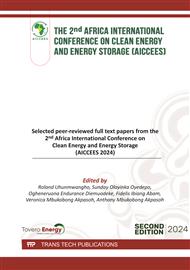p.85
p.121
p.141
p.155
p.165
p.175
p.195
p.205
p.227
Modelling and Optimization of Hybrid Photovoltaic-Wind Turbine with Energy Storage System for Autonomous Electricity Generation
Abstract:
The integration of renewable energy sources, such as photovoltaic (PV) and wind turbines, has gained significant attention due to the growing demand for reliable and clean energy solutions. This paper presents a comprehensive modelling and optimization approach for hybrid PV and wind turbine systems to maximize system performance at the same time minimizing cost and surplus energy. The proposed model incorporates detailed mathematical formulations that capture the interactions between PV modules, wind turbines, and the storage system which is a battery energy storage system (BESS). The model also considers economic factors and methods to reduce the surplus energy of the system. The optimization scheme utilized the African vulture optimization algorithm (AVOA). The AVOA is a nature-inspired meta-heuristic algorithm created based on the hunting patterns of African vultures. In addition, the AVOA was constructed to handle a multi-objective optimization with size and costs as the objective functions. The optimized system provides the best system size to support the electricity supply of a coastline town (4.7231°N, 6.77881°E). The optimized system can deliver 41.80 GWh of energy annually, meeting 98.3% of the energy demands of the community; while the optimized system has a cost savings of 45.11%, with 92.9% penetration. The work provides valuable insights for system designers, energy planners, and policymakers in their efforts to promote renewable energy integration and address the challenges associated with the transition to a low-carbon future.
Info:
Periodical:
Pages:
165-174
Citation:
Online since:
February 2025
Price:
Сopyright:
© 2025 Trans Tech Publications Ltd. All Rights Reserved
Share:
Citation:


